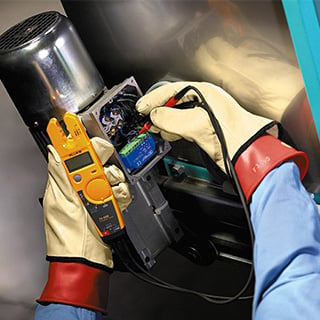Electrical Safety Resource Center

BREAKING: OSHA ISSUES NEW GUIDANCE ON ELECTRICAL ARC FLASH
As of November 26, 2024 OSHA has released new arc flash guidance aimed at reducing arc flash injuries amongst commercial and industrial electricians, which continue to occur despite proven PPE and safety standards like NFPA 70E. It is estimated that over 600,000 workers do not have the necessary PPE to prevent injury from arc-flash hazards. Continue reading to access the OSHA guidance documents and to learn how Cintas can help business of all sizes keep employees save and protected in accordance with OSHA and NFPA70E.
Understanding The Guidance
What does the updated guidance say?
The new guidance was primarily issued to address the two leading causes of arc flash injuries and fatalities in the USA today: claiming work is deenergized which does not qualify (most work fails the standard) and thus having no AR clothing or other PPE; and choosing to work energized when voltage is low (120/208, 277, etc) despite the lack of justification and lack of PPE because of the common and dangerous myth that low voltage isn’t hazardous.
To whom does this new guidance apply?
The new OSHA arc flash guidance applies to all commercial, industrial and residential electrical workers in the USA, and to operators, maintenance and other personnel who work on or near energized electrical equipment at 50V and above.
Why has OSHA taken this action?
NFPA 70E added arc flash safety over two decades ago in 2000, and arc flash PPE has existed for over 30 years; despite this, arc flash injuries and fatalities continue to occur at a significant rate. During 2000-2010 arc flash injuries and fatalities went down at the same rate as compliance with 70E and use of AR clothing went up. However, the injury rate leveled off after 2010 and continues to occur at about half the pre-2000 rate because about half the population to whom 70E applies are not compliant and do not wear AR clothing. Industry, union and safety leaders spent several years researching the causes and working with OSHA. Two issues clearly lead to the significant majority of arc flash injuries and fatalities; OSHA issued new guidance to correct these dangerous myths and save lives.
Where can this guidance be found?
Electrical - Electric-Arc Flash Hazards | Occupational Safety and Health Administration
Arc Flash Safety Articles
Arc Flash Prevention Playbook
6 steps you shouldn't ignore
Why Gear Alone Won't Save Lives
Arc flash training is a critical layer
Perception Isn't Protection
Separating arc flash fact from fiction
Arc Flash Safety
A life-saving reality check
How Can Cintas Help With NFPA 70E?
Cintas is your single source for NFPA 70E Protective Apparel, PPE, & Training

Arc Flash/Shock Hand Protection
- Voltage Rated Gloves (Class 00, 0, 2, 3, 4)
- Arc Rated Knit Gloves
- Leather Protectors

Arc Flash Head Protection
- Hard Hats with Arc Rated Face Shields
- Arc Rated Shrouds and Balaclavas
- Safety Glasses and Ear Protection

Arc Flash Suits
- Category 2, 3, 4, and 4+

Arc Rated Apparel
- Arc Rated Shirts, Pants, and Coveralls
- Arc Rated Base Layers
- Electrical Hazard Rated Boots and Shoes
- Arc Rated Outerwear
- Arc Rated Cleanroom Coveralls, Hoods and Boots

Incident Energy Analysis
- Site Assessment
- Equipment Labeling

Electrical Safety Training
- Arc Flash (Qualified Person)
- First Aid, CPR and AED
- Lockout/Tagout
Arc Flash Safety Series
-
Episode 1 - Top 2 Causes
Watch Now
-
Episode 2 - Don't Wear Fuel
Watch Now
-
Episode 3 - 600,000 Workers At Risk
Watch Now
Additional Safety Resources
-
Electric Arc Flash OSHA Guidance
Watch Now
-
Head and Hand Protection
Watch NowTake the hassle out of managing Voltage Rated Gloves and Arc Rated Head Protection with the industry’s most trusted provider of NFPA 70E Protective Apparel
-
FR Protective Apparel
Be Ready™ with Arc Related Clothing and PPEWatch Now
Pursuant to OSHA regulations, 29 CFR 1910.132 (Subpart I), an employer bears sole responsibility for selecting the type(s) of personal protective equipment to be used by its employees. All purchasers of FRC garments and/or laundering services from Cintas bear full responsibility for selecting the PPE appropriate for use by their employees. Cintas makes no representation, warranty, or covenant with respect to the flame-resistant qualities of the garments or with respect to the fitness or suitability of the garments for any particular use or purpose. The purchase of any goods or services from Cintas is subject to Cintas’s Standard Terms and Conditions and/or any other applicable written contract executed between the purchaser and Cintas relating to such purchase.




